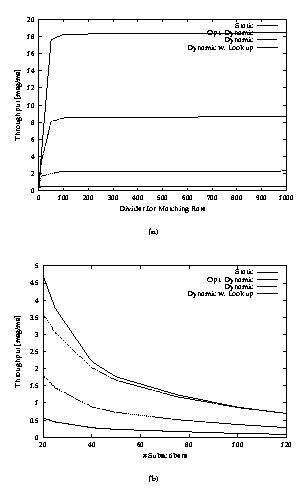



Next: Discussion
Up: Evaluation
Previous: Testbed
We have made a set of extensive tests, in which we have always varied
one of four parameters for the subscriptions. These are namely, (1) the
fraction of positive matches for a subscriber 1/c, (2) the total
number of subscribers s, (3) the maximum nesting level of
invocations for queries a, and (4) the number of different query methods
d at each nesting level.
- Varying 1/c:
- From n produced messages,
an average of n/c messages matched a given subscribers
pattern. Figure 20(a) shows the effect of varying
c. It confirms the intuition that the cost of sending messages with
UDP does not depend on the matching scheme, and can be seen as
fixed. With c > 100 in this scenario, the pure cost of matching
is measured. In order to accentuate the differences
between the matching schemes without contradicting our concrete applications,
we have chosen c = 10 for the next figures.
- Varying s:
- Similarly to the scenario in Figure 18,
we have chosen one basic condition per subscriber.
Figure 20(b) reports the effect of scaling up s, conveying that
the two optimizations are almost equivalent with a large
s.
![[*]](foot_motif.gif) As shown in the previous figure, UDP is a limiting factor with an
increasing number of sends (here due to a large s). Performance
drops faster with static filters, since every
additional subscriber involves a full pattern evaluation. In contrast, the optimized
dynamic scheme is less sensitive since redundant queries are avoided.
As shown in the previous figure, UDP is a limiting factor with an
increasing number of sends (here due to a large s). Performance
drops faster with static filters, since every
additional subscriber involves a full pattern evaluation. In contrast, the optimized
dynamic scheme is less sensitive since redundant queries are avoided.

Figure 20: Matching Rate and Number of Subscriptions
- Varying a:
- The probability of
having i (in [0..a]) nested invocations was chosen as pa = 1/(a+1).
Increasing a reduces throughput
with static invocations (Figure 21(a)), since
static accessors comprise more invocations. Similarly, the optimized
dynamic scheme is less efficient with an increasing a, since the
total number of performed methods increases with the depth of the tree.
- Varying d:
- One of d methods
was chosen at each nesting level with a probability of pd = 1/d.
Varying d obviously does not influence static filter
evaluation. On the other hand, increasing d might lead to
increasing the potential number of edges leaving from any node in the
invocation tree. The resulting performance loss is directly visible in
Figure 21(b).
The optimized dynamic scheme is however more penalized by increasing
a, as shown in the previous figure. This is due to the fact that
increasing a by 1 might result in up to d new
edges in every former leaf of the invocation tree.
Interestingly the optimized dynamic matching scheme never
overperforms the static scheme, even if the speedups become close with
a large number of message sends. One could believe that with a strong
redundancy between patterns and a large number of subscribers the
dynamic scheme would become more efficient. Even with extreme
parameter values, we have however never encountered such a scenario.

Figure 21: Expressiveness and Redundancy of Subscriptions



Next: Discussion
Up: Evaluation
Previous: Testbed
Patrick Eugster
12/10/2000
![[*]](foot_motif.gif) As shown in the previous figure, UDP is a limiting factor with an
increasing number of sends (here due to a large s). Performance
drops faster with static filters, since every
additional subscriber involves a full pattern evaluation. In contrast, the optimized
dynamic scheme is less sensitive since redundant queries are avoided.
As shown in the previous figure, UDP is a limiting factor with an
increasing number of sends (here due to a large s). Performance
drops faster with static filters, since every
additional subscriber involves a full pattern evaluation. In contrast, the optimized
dynamic scheme is less sensitive since redundant queries are avoided.


